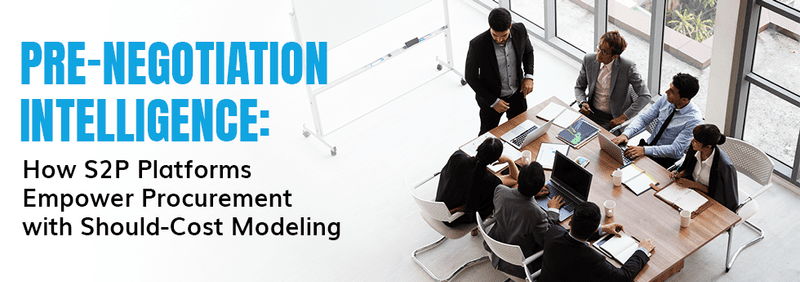In procurement, knowledge is power, especially when it comes to supplier negotiations. Without visibility into a supplier’s cost structure, buyers often rely on historical pricing or competitive bids, leaving potential savings on the table. But what if procurement teams could challenge supplier pricing with real-time market data and granular cost breakdowns?
This is where pre-negotiation intelligence transforms the game. By leveraging should-cost modeling and real-time market data, buyers can move beyond guesswork and challenge supplier pricing with precision.
Table of Contents
ToggleThe Challenge: Blind Negotiations in Complex Manufacturing
Imagine a mid‑sized electronics manufacturer sourcing custom PCBs. Their supplier proposes a 15% price increase. The buyer asks: “Why?” The supplier cites energy, labor, and material cost hikes. Without data, it is a blind negotiation. But what if the buyer could back that challenge with hard intel?
The Solution: Should-Cost Modeling & Real-Time Market Data
Modern Source-to-Pay (S2P) platforms are changing the game by enabling buyers to:
- Deconstruct supplier pricing using real-time market benchmarks.
- Model “should-cost” estimates based on material costs, production processes, and regional labor rates.
- Challenge quotes confidently with data-driven insights rather than assumptions.
For example, a manufacturing firm sourcing a precision-machined component can use should-cost analysis to determine fair pricing by factoring in:
- Raw material costs (e.g., aluminum, steel)
- Machine time & labor efficiency
- Supplier overheads & profit expectations
Why S2P + Should‑Cost = Next‑Gen Procurement
Benefit | Description |
Fact‑Based Negotiations | Buyers avoid gut-feel debates; they leverage live data and cost breakdowns
|
Transparency & Collaboration | Shared understanding fosters trust and joint efficiency initiatives. |
Dynamic Risk Management | Market shocks (commodity swings, tariffs, labor) flow into models; buyers anticipate impact before quotes arrive. |
Strategic Cost Control | Over time, models guide decisions like local vs offshore manufacturing, material substitutions, or vertical integration. |
Faster Product Development | Engineers can estimate production cost mid-design and adjust BOMs proactively. |
The Strategic Shift in Procurement
The real value of should-cost modeling isn’t just short-term saving; it’s fostering more collaborative supplier relationships. When buyers can pinpoint inefficiencies (e.g., excessive machining time, suboptimal material usage), they shift discussions from adversarial haggling to joint problem-solving.
Forward-thinking manufacturers are taking this further by:
- Integrating should-cost analysis into new product development, designing for optimal procurement from the start.
- Aligning procurement strategies with sustainability goals, such as identifying cost-efficient low-carbon materials.
S2P Platforms: The Backbone of Transformative Negotiations
Key Capabilities of Modern S2P Platforms
- BOM ingestion and cost feed integration, to automatically recalibrate should-cost models with current commodity, wage, and logistics benchmarks
- Negotiation tools, offering shared dashboards, indexed proposals, and comment threads transforming pricing discussions into collaborative exchanges.
- Indexed pricing agreements, tying contract rates to real-world metrics, so that a rise in aluminum or diesel prices isn’t a surprise, but a planned variable.
Conclusion: From Negotiation to Strategic Partnership
When procurement teams in manufacturing shift from reactive haggling to proactive intelligence, anchored by real-time should‑cost modeling, they unlock:
- Sharper pricing outcomes
- Deeper supplier partnerships built on mutual visibility
- Strategic agility to navigate market volatility
- Cost-engineered innovation during product design
In short, S2P platforms with real-time cost structure intelligence transform procurement into a value‑creation engine, not just a cost function.



